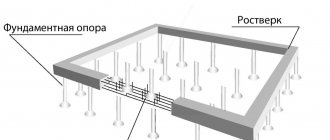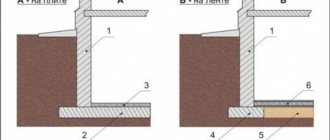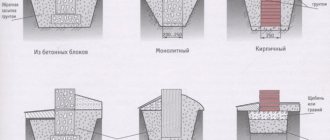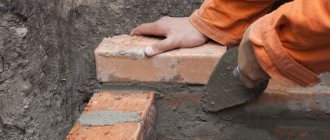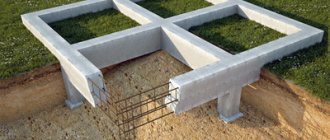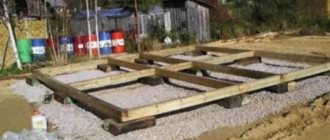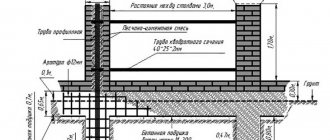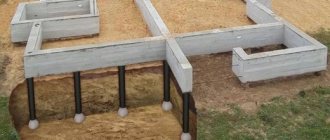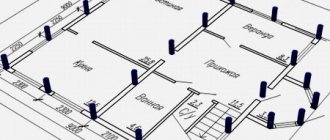To set up a greenhouse for year-round use, it is important to install a foundation. There are several types of foundations. But before installing them, it is necessary to perform a number of preparatory works, which are the same for all types. It is also necessary to sensibly assess your own capabilities, because installing a foundation requires a lot of time and effort.
The need for a proper polycarbonate greenhouse foundation
Many gardeners are interested in whether a polycarbonate foundation is needed for a greenhouse. There is no need for a foundation for a temporary structure. But if you plan to operate the greenhouse for a long time, then it is worth building the right foundation.
Advantages of using a foundation:
- The design becomes more durable and reliable. The greenhouse is affected by wind, precipitation and other unfavorable conditions. If you do not take care of the foundation, the greenhouse may move.
- With the right choice of base type, it becomes possible to protect seedlings from pests and weeds.
- The necessary thermal insulation is created for growing crops in winter.
Thanks to the foundation, the greenhouse becomes stronger and more reliable. It can withstand heavy loads and ensure comfortable growing of plants. It is imperative to install a foundation in winter greenhouses.
To properly equip the foundation, you need to choose the optimal type of foundation. Each of them has its own characteristics, positive and negative aspects.
At the same time, seasonal construction does not require a foundation. This is just an unnecessary waste of money, effort and time. Summer residents often build a small greenhouse only in the spring for propagating seedlings, after which they dispose of it. But for long-term use of a greenhouse, a reliable foundation is required.
Do you need a foundation?
You shouldn’t rush into purchasing materials to build a foundation for a greenhouse. The first step is to determine whether it is really needed. To determine this, you need to analyze several points:
- whether it will be attached to the main building;
- will it be used all year round?
- whether the greenhouse is installed in a remote area;
- is there a recess inside;
- what are the dimensions of the greenhouse;
- what is the location of groundwater;
- Is the greenhouse located on a slope?
In all these cases, the construction of a foundation for the greenhouse will be mandatory. If the greenhouse is visited from time to time, the foundation will provide additional protection against intruders. If a recess is made inside the greenhouse below freezing of the soil, then the foundation is also important. This move is being made for year-round cultivation of crops. In the case when groundwater comes close to the surface, the foundation will help keep the entire structure in the required position. It is also worth correctly assessing the size of the greenhouse. If the dimensions are significant, you will need a base to make the frame stable.
It is important to think about the construction of the foundation in the case when glass panels are used as a covering. They have significant weight, therefore they exert significant pressure on the ground and an additional foundation is needed. In some designs, metal corners act as stiffening ribs. They also require a good foundation so that the structure does not sink into the ground. It’s easier for those who built a greenhouse from polycarbonate. This material is lightweight, so it can be installed perfectly on a frame without a base. The foundation for a greenhouse will be relevant if the area is famous for strong winds. Due to its windage, the structure can easily be overturned or moved from its place.
Note! In some cases, it may be necessary to move the greenhouse to another location, so the construction of a foundation is not required in this case.
Types of foundation for a polycarbonate greenhouse
First, you need to identify the purpose of building the foundation. Only then can you choose the right foundation. It is necessary to take into account the term of greenhouse operation. For year-round use you will need a strong base. Sometimes only a protective barrier is erected against insects and weeds.
Types of foundation:
- Concrete strip;
- Pillars;
- Piles;
- Monolithic slab.
Each type has its own characteristics of use. Concrete foundations are the most popular among summer residents. Pillars and piles are a more economical type of foundation. A monolithic slab provides the most reliable foundation.
When choosing the optimal type of base, you need to take into account the type of soil, terrain, greenhouse area, climatic conditions and period of construction.
Many species may require preliminary leveling of the soil. This is especially true for a monolithic slab. It is necessary to install such a foundation on the most flat surface possible so that the greenhouse does not tilt during operation.
Why do you need a foundation for a greenhouse?
A polycarbonate base for a greenhouse is necessary. Its main tasks include reliable fixation of the structure. An unsecured greenhouse can tilt during operation and even fly away into the neighbors' garden in strong winds, since polycarbonate structures have a large windage. In addition, if the greenhouse is attached to the ground without any foundation. It will certainly squint after the first winter, due to the movement of the soil. As a result, the polycarbonate may crack, the doors will not open or close well, and the appearance of the greenhouse will certainly be far from ideal.
The foundation for a small structure can be varied:
- block;
- brick;
- lumber;
- monolithic;
- spot
Let's consider each option in detail.
Features: how to install a polycarbonate greenhouse without a foundation
If the greenhouse is installed only during the warm season, then a foundation is not needed and you can save on materials and time. But such installation has its own characteristics. First you need to choose the right place to install the greenhouse.
It is necessary to study the soil and choose a well-lit area. If the soil is sandy, then this is a good basis for planting vegetables. If the soil is made of clay, then the top layer will need to be replaced. The place itself should be well lit. There is no need to build a greenhouse next to buildings that will cast a shadow on the greenhouse. If the soil is wet, you will have to install a drainage system.
Installing a greenhouse without a foundation:
- Preparatory work. It is necessary to determine the perimeter of the greenhouse and mark it with pegs and ropes. Changes and unevenness on the ground are no more than 5 cm.
- You need to dig a trench 30 cm wide. The depth of the channel depends on the height of the support. The bottom must be compacted well. The trench must be covered with slate or roofing felt to protect the ground from weeds.
- Frame assembly. You need to start with the end walls. You also need to secure window and door frames. The wooden frame must be treated with antiseptics.
- Installation of polycarbonate. You need to start with the end walls. It is important to secure the layers on the correct side so that the protective layer comes out.
You can install a frameless greenhouse yourself. It is important to ensure that the building does not come out crooked. To do this you need to use special tools.
Most often, frameless greenhouses are used for seedlings. You can read about their arrangement at the link:
Do-it-yourself greenhouse foundation
Let's consider several options for constructing a foundation yourself.
Simple option
The cheapest way is to fill the ditch with gravel or broken bricks:
- Mark and clean the area, remove the turf.
- Dig a ditch 20-30 centimeters deep.
- Install metal or plastic hollow pipes at the points where the supports will be located.
- Fill the lower part of the ditch with sand, the upper part with crushed stone or brick, compact it flush with the ground.
- Insert support pins into the tubes.
Brick strip
You can make a ribbon of bricks (in particular, use a brick from a disassembled stove):
- Marking and cleaning the site (performed equally for all types of tapes).
- Dig a ditch.
- Lay a gravel bed.
- Fill with concrete about 5 cm thick.
- Lay one or two layers of roofing felt.
- Coat the bricks with a hydrophobic compound to extend their service life.
- Make brickwork of the required height and width. The support pins are placed between the bricks and filled with mortar.
Sleeper foundation
Another inexpensive option is a base made of sleepers or logs. Logs should be pre-coated with bitumen mastic or heated bitumen; sleepers do not need to be treated. This type of foundation is suitable for a wooden greenhouse, made of polycarbonate or metal sheets. Procedure:
- Marking and cleaning.
- Lay sleepers around the perimeter of the site. Cut off the excess.
- Check installation with a level.
- Fasten to each other with construction staples.
Columnar foundation
- Mark and clear the site. Mark the installation locations of the supports with pegs.
- Drill holes to the required depth.
- Install greenhouse frame pins made of polycarbonate or other lightweight material into the holes.
- Fill the holes with concrete or fill them with gravel and compact them.
Concrete column foundation
- Mark the site, prepare the holes.
- Pour crushed stone onto the bottom and compact it.
- Install formwork (for example, old leaky buckets will do).
- Place the embedded elements to install the supports of the structure frame.
- Pour concrete.
- Weld support pins to the mortgages.
Brick pillars
- Mark the area, make holes, compact it with crushed stone.
- Lay roofing felt.
- Lay out brick columns, place metal embedded elements for supports between the bricks.
Wooden pillars
- Prepare the site and holes.
- Treat scrap logs for posts with tar or hot bitumen.
- Place in the holes.
- Fill the space between the logs and the walls of the holes with fine gravel and compact it.
- Lay wooden boards on top of the logs, which will serve as a grillage. The boards should be pre-treated with a water repellent and antiseptic.
How to make a foundation for a polycarbonate greenhouse: preparation
Any construction involves preparatory work. It is necessary to choose the right location and assess the condition of the soil. In some cases, the top layer needs to be replaced.
Preparatory work before installing the foundation:
- Cleaning the area. Clearing it of debris, stones, dry branches.
- It is necessary to measure the evenness of the surface. To do this, in several places you need to measure the ground with a building level. If necessary, it is necessary to level the soil. Add soil somewhere, remove it somewhere. The top layer needs to be replaced.
- Creating markup. Before work, you need to make drawings and, following them, you should place the pegs and tighten the rope.
After this, it is necessary to dig a trench and install reinforcement. The dimensions of the greenhouse depend on the frame itself. You need to take into account its weight and material of manufacture. If this is a classic greenhouse with a metal profile frame with polycarbonate sheets, then the depth should be 50 cm and the width should be 30 cm.
For a winter greenhouse, you need to make formwork for the base, the size of which should be 30-60 cm in height. The trench itself must be covered with waterproofing film.
To create waterproofing, you can use polyethylene film or geotextiles.
You will also need to install an armored belt. It is simpler to perform and looks lighter than the standard option for residential buildings. It is necessary to stick steel rods into the bottom. The length of one twig is 60 cm. 30 cm are dipped into the ground, and the remaining height is on the surface of the soil. The rods must be connected using thick wire.
Timber base
A wooden foundation is perhaps one of the most common types of foundations for greenhouses today; its advantages include low cost, mobility and quick construction. By installing the greenhouse on a timber base, all installation work can take only one day.
But when installing on timber, the features of polycarbonate greenhouses should also be taken into account. One of the main ones is that a perfectly flat surface is required for installing the frame and subsequent polycarbonate cladding. Otherwise, the arcs may be different in height, which will lead to problems with the sheathing of polycarbonate sheets and a loose fit of the material.
Usually, 100x100 timber is used for installation, but it is quite possible to install the structure on a board measuring 50x150. So, the most important thing when installing on a wooden base is to take the correct measurements.
- First, a frame is knocked together, which must completely match the size of the greenhouse frame.
- Next, the knocked together frame must be set exactly level; for this you will need a building level. If you have large differences in elevation on your site, then in the future you will have extensive work to dig the structure into the ground, provided that you want the greenhouse to stand level.
- When all sides of the base are level, you need to check for correctness. To do this, measure the diagonals. They should not differ more than 2 cm from each other.
- In this option, the wooden base is buried in the ground after assembling the entire greenhouse, but another method can be used.
The foundation for a polycarbonate greenhouse, made of timber or boards, is easier to install in a pre-prepared trench.
- The depth for a size of 100x100 mm should be 15 centimeters. The width should be 8 cm greater than the width of the material.
- Be sure to add gravel or crushed stone to the bottom of the prepared trench; this will prevent the wooden base from being exposed to excess moisture.
- Having lowered the wooden base, all its sides must be strictly level.
- The corners of the base are fixed with construction corners, and the voids between the walls of the trench and the timber are filled with soil.
In addition, when constructing a foundation from a wooden base, be sure to ensure that it is treated with special antiseptic materials that protect the wood from harmful insects and rot.
Installation of a polycarbonate greenhouse on a timber foundation can be done not only on a gravel base, but also on a waterproofing material, which also protects the wooden structure from the harmful effects of water and excessive humidity.
Pouring a foundation for a polycarbonate greenhouse with your own hands
Pouring the solution can take place according to two scenarios. In the first option, you should make a sand base. You need to pour 15 cm of sand and compact the soil well. After this, reinforcement is installed and cement mortar is poured. In the second option, you need to fill in 10 cm of sand and 10 cm of crushed stone. After compacting and installing the armored belt, you can pour the solution.
Brands of concrete for pouring the base for a polycarbonate greenhouse:
- M100. Together with sand and crushed stone, a solution is prepared that can withstand a load of up to 100 kg per 1 cm2.
- M200. With crushed stone and sand, you get a strong foundation that can support a weight of 200 kg per 1 cm2.
Most greenhouses are installed under the first grade of concrete. This turns out to be enough. The strength of the foundation depends on the proportions of all components of the solution.
We pour the solution into the trench, provided that 5 cm remains to the edge of the soil. The armored belt should also be covered by 5 cm. It is necessary to quickly pour the concrete so that the solution does not have time to harden before it is evenly distributed throughout the trench. After this, it is necessary to cover the foundation with polyethylene.
After 3 days, the solution will have time to harden. Then you can begin to install the polycarbonate greenhouse. If the greenhouses are heavy, you will have to wait a month. If these terms are not observed, the base will begin to deform.
You can install a ready-made polycarbonate greenhouse from the manufacturer on the foundation. The criteria for choosing a quality product are described in our material: https://homeli.ru/dvor-i-sad/teplitsy/teplitsy-iz-polikarbonata-ot-proizvoditelya
Types of foundations for light greenhouses
The foundation for a greenhouse is selected according to the same principle as the foundation for small residential and domestic buildings. The only difference is that there is no need to build a buried foundation.
A polycarbonate greenhouse can be built on light types of foundation, since its weight does not exceed 100 kg. In this regard, we can conclude that the following types of foundation are quite suitable for a light greenhouse:
- Monolithic concrete tape, which is made in the form of a continuous strip along the entire perimeter of the greenhouse. The strip base can be completely immersed in the ground or raised above the ground. To make a strip base for a polycarbonate greenhouse, you can also use aerated blocks or concrete blocks of a standard shape.
- A monolithic slab is located under the entire base area. Just like the tape can be completely or partially immersed in the ground. A monolithic base is used very rarely. In most cases, this type is used in the construction of large greenhouses and greenhouses equipped with underground heating.
- The point base consists of columns made of concrete, brick or stone. This type of foundation includes pile-grillage structures.
- A wooden base can also be called a point base, since the basis of the structure is free-standing wooden supports. Sleepers can be used to construct a grillage.
The most popular among gardeners and summer residents is the foundation in the form of strips or pillars. This is explained by the fact that the monolithic slab completely covers the soil under the greenhouse. This factor is of great importance for those who value every centimeter of land.
The choice of foundation for a greenhouse is influenced by many factors, therefore, having decided to independently build a greenhouse on a high-quality foundation, you need to do the following:
- Determine the type of soil on the site.
- Determine the weight of the future structure.
- Draw up a drawing of the greenhouse and calculate approximate costs.
- Choose the optimal time for construction.
- Calculate your own strength based on all the above points.
How to install a polycarbonate greenhouse with a monolithic foundation
First you need to do the preparatory work. To do this, you need to clear the soil, make markings, remove the top layer of soil and dig a pit. Its depth should be 30-40 cm. It is also necessary to cover the bottom with polyethylene or geotextile.
Sequence of installation of a monolithic foundation:
- Installation of concrete footing. You need to pour the solution onto the sand layer and level everything thoroughly.
- Creation of formwork.
- Lining walls and concrete bases with roofing felt or slate.
- Reinforcement. It is necessary to install steel rods and wrap them with thick wire.
- Pouring concrete solution. You need to do this procedure quickly enough so that it does not have time to harden.
All operations are similar to installing a strip foundation, only the scale will be larger. The coating of a monolithic slab must be periodically moistened. After a day or two, you need to install the anchors and leave the surface in this form until completely dry. After final drying, it is necessary to install roofing material on top of the slab.
The drainage inside the greenhouse must be taken care of before pouring concrete.
You can do all the work yourself. But you need to understand that installing a foundation requires a lot of effort, money and time. In this case, you cannot pour concrete gradually. You need to do this in one go.
Examples of a polycarbonate greenhouse foundation (photo of ideas)
- Author: admin
Rate this article:
- 5
- 4
- 3
- 2
- 1
(0 votes, average: 0 out of 5)
Share with your friends!
